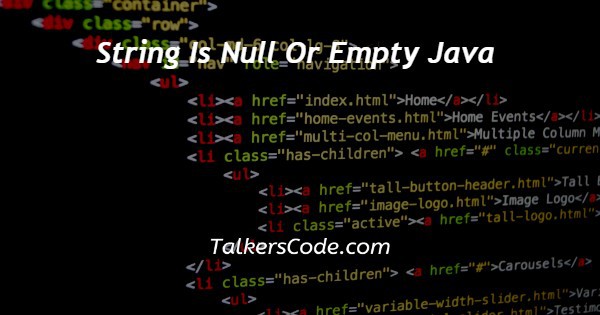In this article we will show you the solution of string is null or empty java, when working with strings in Java, it's crucial to manage situations in which a string could be empty or null.
Unlike null strings, which have no value associated with them, empty strings are string objects with no length.
To guarantee the accuracy and stability of your code, handling null or empty strings is essential.
When a string is null, attempting to operate on it may cause unexpected programme crashes known as NullPointerExceptions.
Similar to this, if some actions aren't done correctly when a string is empty, they could have undesired consequences or result in errors.
Java has strategies and methods to determine whether a string is empty or null, enabling you to handle these situations successfully.
You may make sure that your programme operates as planned and prevent potential errors or undesired outcomes by validating and handling null or empty strings.
Now we'll discuss the idea of a string being null or empty in Java.
Step By Step Guide On String Is Null Or Empty Java :-
import java.util.Scanner;
public class StringNullOrEmptyChecker {
public static void main(String[] args) {
Scanner scanner = new Scanner(System.in);
System.out.print("Enter a string: ");
String input = scanner.nextLine();
if (isNullOrEmpty(input)) {
System.out.println("The string is null or empty.");
} else {
System.out.println("The given string is not empty or null.");
}
scanner.close();
}
public static boolean isNullOrEmpty(String str) {
if (str == null) {
return true;
}
if (str.length() == 0) {
return true;
}
String trimmedString = str.trim();
if (trimmedString.isEmpty()) {
return true;
}
String regexPattern = "\\s*";
if (str.matches(regexPattern)) {
return true;
}
return false;
}
}
- You can see that we wrote java code to indicate that the string is null or empty in this place.
- In order to read user input, we start our code by importing the Scanner class from the java.util package.
- Next, we create the main() method for the StringNullOrEmptyChecker class. This acts as the program's starting point.
- To read user input from the console, a new Scanner object is created inside the main() method.
- Using System.out.print(), we print the message "Enter a string:" to ask the user to enter a string.
- Using the scanner, we read the user's input and store it in a variable named input.the nextLine() function.
- The input string is then passed as an argument to the isNullOrEmpty() method in order to determine whether it is null or empty.
- Several techniques are used in the isNullOrEmpty() method to determine whether the string is empty or null:
- We determine whether the str parameter equals null.
- If it is, the string is considered to be null and the procedure returns true.
- Using the length() method, we determine if the string's length equals zero.
- The method indicates that the string is empty if it returns true in that case.
- To get rid of the string's leading and trailing whitespace, we use the trim() method.
- We then use the isEmpty() method to verify that the trimmed string is empty. The method returns true if it is empty, indicating that the string is empty.
- A regular expression pattern called s* is created; it can be used to match any amount of whitespace characters.
- We use the regular expression pattern to give the string to the matches() method.
- If the pattern is met by the string, the procedure returns true, indicating that the string is empty.
- When we return to the main() method, we check to see if the string is null or empty using the outcome of the isNullOrEmpty() method.
- Depending on the outcome, we print the relevant message to the console.
- To release system resources used by the Scanner object, we finally call the scanner.close() method.
Conclusion :-
Thus, we have effectively mastered the Java concept of a string being null or empty.
We also discovered that it checks for nulls, and length, trims the string and uses regular expressions to determine the string's state.
The code enables us to validate user input & handle null and empty strings appropriately by implementing these tests.
I hope this article on string is null or empty java helps you and the steps and method mentioned above are easy to follow and implement.














